Table of Contents
Here’s everything you need to know when grocery shopping for kids in 2024, according to a dietitian mom. Some of these recommendations will surprise you!
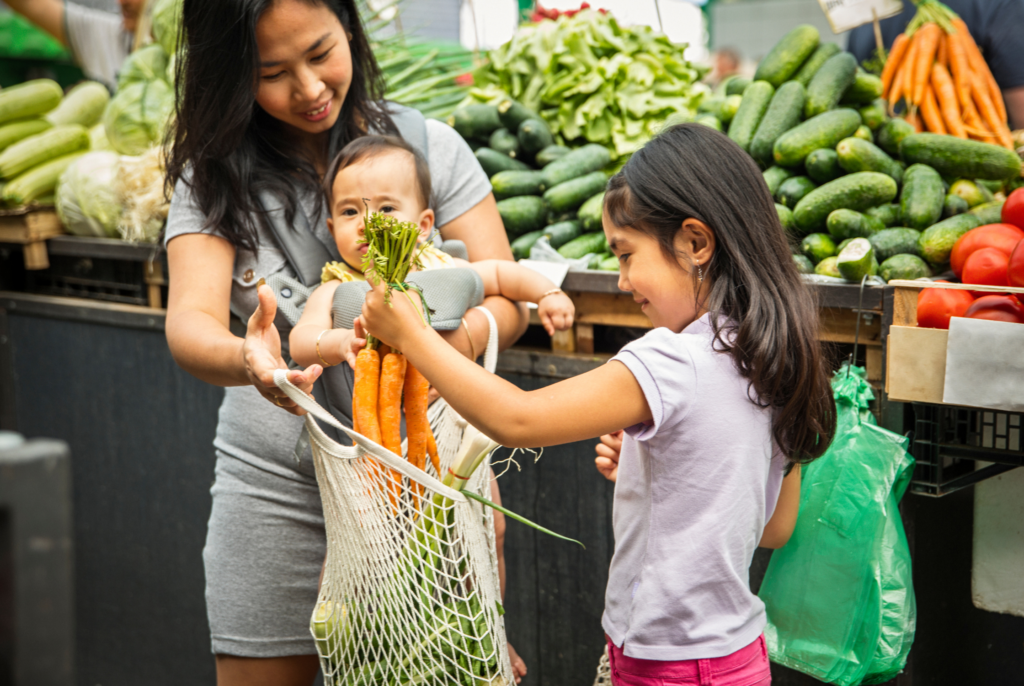
This post was written in partnership with my friends at CropLife Canada. As always, opinions are my own!
As a dietitian and mom of three, I understand the challenges of creating nutritious meals and snacks for your family week after week. Navigating the grocery store can feel overwhelming when you consider factors such as cost, individual preferences, picky eating challenges, storage space, and health considerations.
When it comes to the health and nutrition part, we are all bombarded with conflicting opinions and loads of misinformation daily, which confuses parents even more. “Eat this and not that” or “Only buy organic fruits and veggies” or “watch out for these toxic ingredients” are some examples of what you may come across on social media from “health influencers” who often don’t have the education or experience to back up their claims.
I often notice stressed-out parents in grocery store aisles scrutinizing labels, uncertain about what to prioritize and why. And that’s precisely why I’m writing this post! To provide you with the essential information to make confident and informed grocery choices for your family.
In this post, I’ll cover everything you need to know about grocery shopping for kids in 2024 including:
Table of contents:

Menu plan when grocery shopping for kids
One of the best ways to save time and money while grocery shopping is to have a grocery list in front of you that you can check off as you go! In other words, you have a plan in place, minus the extra impulse buys filling your cart (and draining your wallet!). I’ll be the first to admit that meal planning isn’t always the most exciting task, but it can be a great opportunity to get your kids involved in the process. Giving your child the authority to help decide part of the meal plan (such as choosing a new vegetable/fruit, or picking out a family recipe), will improve the likelihood of them exploring *and maybe even eating* the foods they helped pick out!
If sitting down and writing out a menu and grocery list isn’t for you, a quick trick that will help keep you organized (and prevent food waste) is to snap a photo of the inside of your fridge/pantry before you head to the store. Why? Use the picture as a guide while navigating aisles to avoid buying duplicates! This also allows you to brainstorm items you might need to make complete meals with the more perishable groceries you have leftover at home.

Consider online grocery shopping
As a busy parent, online grocery shopping can be a real lifesaver when it comes to conserving your time and energy! This is especially true when every grocery store outing also requires bundling up little ones …inevitably taking even more time (and patience) to complete the journey.
Many online grocery shopping platforms also offer home delivery services. Score! To top it off, saving money and reducing food waste are welcome benefits that naturally happen with online shopping. You will also notice that impulse buys of new flashy products (that often become food waste) can drastically decrease when you’re not physically in the store.
Of course, physically going to the store can be fun and have its benefits! It’s a great opportunity for them to see, touch, and smell different foods and learn about the process of grocery shopping. This is why I am all about including a combination of both online and in-person shopping. When planning an in-person grocery shop, I try to choose less busy times to go such as early morning on the weekdays, or in the evening after supper time.
What to buy at the grocery store for your family
So you’ve got your menu plan down, now… what to buy?! This part feels the most daunting for parents, especially when we’re bombarded with diet culture’s “dos” and “don’ts” of grocery shopping for kids. While variety in food and nutrients is important for your child’s growth and development, this doesn’t mean multiple trips to the grocery every week or buying fancy and expensive items. Here’s my best advice: stick to your tried-and-true favorites, while sprinkling in a bit of variation now and then (when the inspiration strikes!). When it comes to the categories of food to purchase, here’s what I recommend:
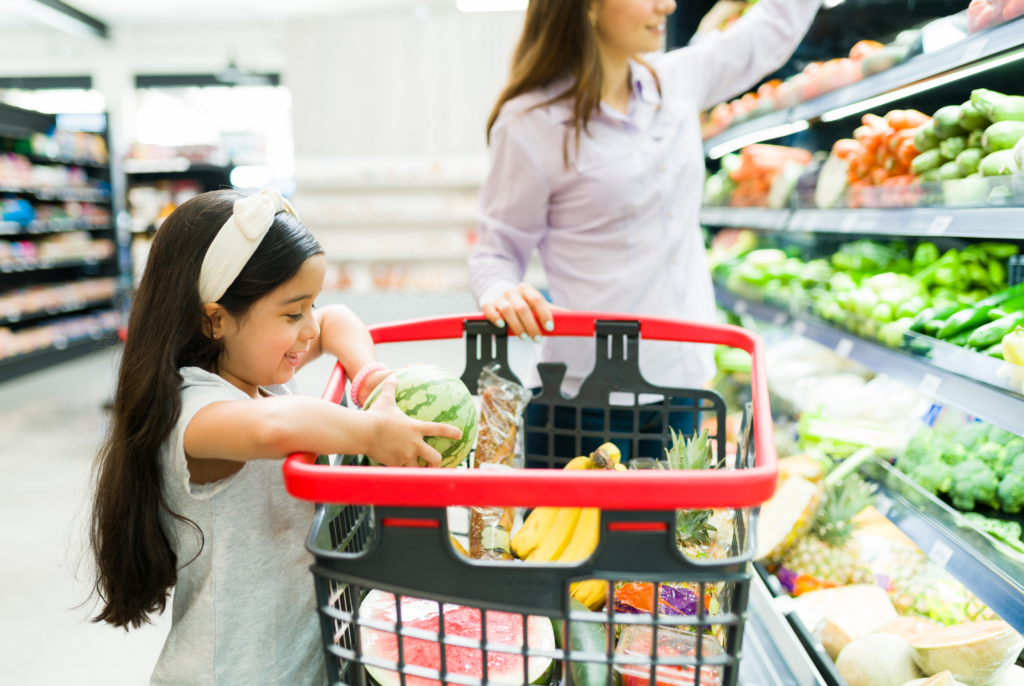
Produce:
This includes your family’s favorite vegetables (leafy greens, bell peppers, broccoli, zucchini, carrots, cucumber, tomatoes, corn, mushrooms, eggplant, etc.) and fruit (apples, oranges, pears, banana, mango, grapes, peaches, plums, etc.).
What they provide:
Much of the protective antioxidants, essential vitamins, and minerals, as well as dietary fibre, come from this food group! And did you know? It is not necessary to purchase organic produce and it is often more expensive than conventional produce. Both types of produce are equally as safe and nutritious for your family! Read more about this below.
Dairy/ Dairy Alternatives:
Depending on your family’s needs and preferences you can choose either plant-based or regular dairy at the grocery store (or both!). Milk, cheese, yogurt, and kefir all provide a good source of protein and calcium for your child.
What they provide:
Plant-based dairy products are often fortified with calcium, but double-check the label to be sure. Cow’s milk is fortified with vitamin D, and most plant-based milks are as well (again double check the label to be sure!). Regular dairy products tend to be higher in protein when compared to plant-based alternatives. This may be something to consider if you’re relying on this group as for a source of protein.
Meat/ Meat Alternatives:
This includes animal sources of protein (i.e. beef, poultry, pork, fish, shellfish, and eggs) as well as plant-based sources of protein (i.e. chickpeas, beans, lentils, tofu, tempeh, peanut butter, nuts, and seeds).
What they provide:
Foods from this category provide the building blocks for growth and development as well as essential minerals such as iron and zinc! Legumes, nuts, and seeds are also packed with fibre and (in the case of nuts and seeds) healthy fats.
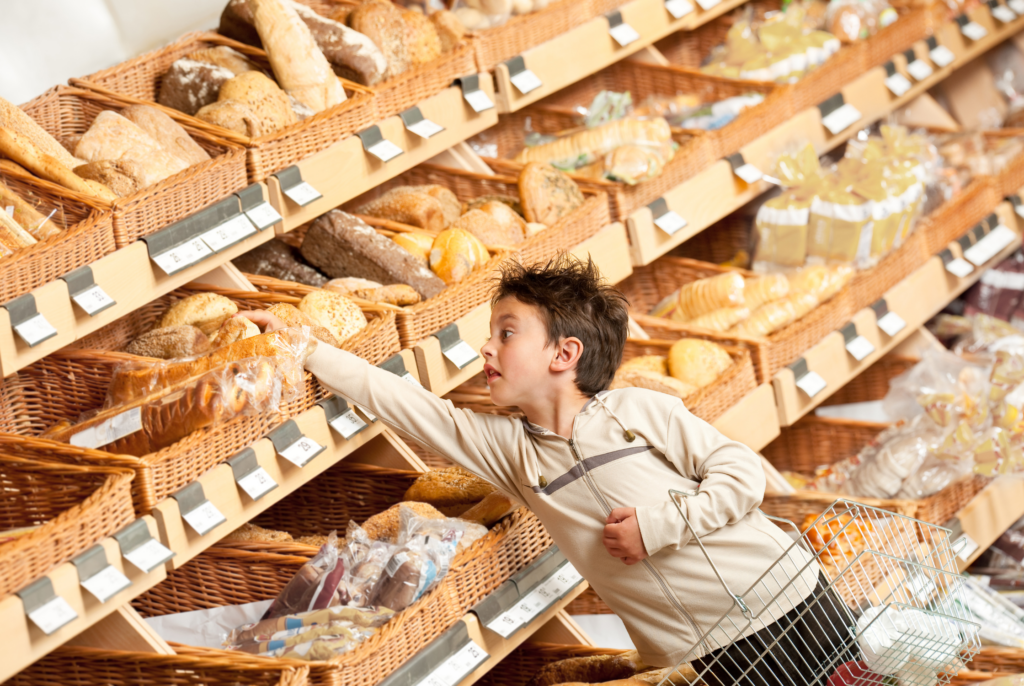
Grains and Starches:
This includes dried grains (such as rice, quinoa, barley, oats, and buckwheat, etc.), dried and fresh pasta, crackers, granola, breakfast cereal, bakery goods (bread, tortillas, naan, etc.), potatoes, yams, pumpkin, and winter squash (acorn squash, butternut squash, etc.).
What they provide:
This category of food is packed with carbohydrates, which is the body’s main source of fuel and essential for brain function and energy production! Grains and starches also are rich in fibre, B vitamins, antioxidants, and potassium.
Fats and Oils:
At the grocery store pick up oils that can handle high heat (i.e. canola oil, avocado oil, grapeseed oil, etc.) as well as lower heat options that add both flavor and nutrition (olive oil, butter, and unrefined coconut oil).
What they provide:
Dietary fat is essential for your child’s brain development, hormone production, and nutrient absorption, and is a concentrated source of energy. Let’s not forget that adding fat to food also enhances both the flavor and satisfaction you get from a meal!
“Just Because” Foods:
What is this food category, you ask? These foods include your family’s favorite cookies, granola bars, sugary cereals, brownies, chocolate bars, chips, cheezies, ice cream, candy, etc. which you include on occasion for the sheer purpose of enjoyment! Why do I recommend you add these products to your family grocery list? It comes down to the simple goal of putting all foods on a level playing field to foster a food-neutral home. When you create a food-neutral home, your child isn’t forced to moralize foods or feel bad for wanting to enjoy more “processed” food products. Ultimately this food philosophy will help prevent disordered eating tendencies, and enable your child to develop a positive relationship with food in the long run!
What they provide:
These foods bring your family the value of enjoyment, pleasure, and satisfaction without a major focus on ingredients or nutrition.
Why you shouldn’t just shop the periphery of the grocery store
Can we please stop telling people to “just shop the perimeter”? If I had quarter for every time I heard that…. The issue I have with this advice is that if people follow it to a T, it will limit your household’s access to a variety of nutritious (and cost-effective) food products found in the centre aisles (such as whole grains, cereals, pasta, legumes, nuts, seeds, canned goods, etc.).
This recommendation stems from diet culture and instills fear in parents to avoid feeding their kids “processed foods” with “toxic ingredients”. The truth is, foods found in the centre aisles are not only nutritious, but also budget-friendly. I think it’s safe to say we can put that old advice to bed!
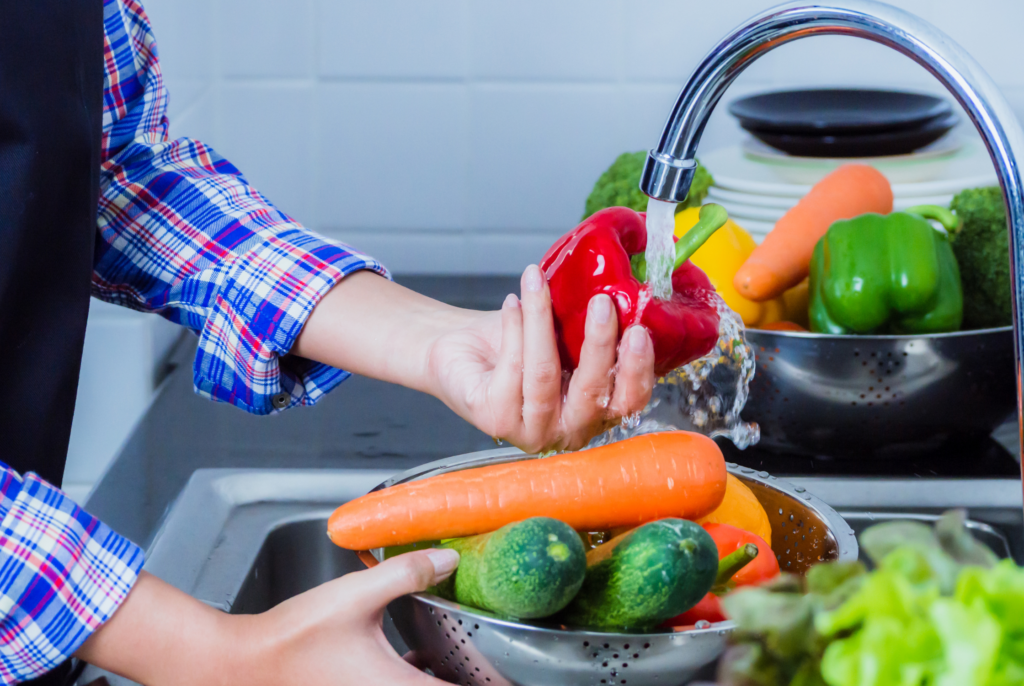
What about pesticide residues? Is organic food better?
The use and safety of pesticides is largely misinterpreted in the health and wellness space. Unfortunately, wellness culture can often lead people to believe that pesticide residues are damaging to you and your family’s health. Here’s the truth: different types of pesticides are used in both organic and conventional farming to protect food crops from damaging insects, weeds and rodents. The amount found on fruits and veggies is extremely low as government health agencies (such as the Canadian Food and Inspection Agency) often set the maximum residue limits 100x (or more) below levels that would have any impact on human health. Did you know an adult woman could eat 850 apples in one day without experiencing any negative impact from pesticide residues? (Whoa!)
More great news? Say goodbye to that expensive produce wash…and you can also ease up on unnecessary peeling or scrubbing with vinegar and lemon juice. All you need to do is rinse and gently rub fruits and veggies under cool running water!
But what about organic produce? Shouldn’t I be feeding my family organic food? The answer: feeding your family organic food is 100% a personal choice. However, also know that organic food is not “healthier” than its conventional counterparts. The best thing parents can do is aim to purchase a variety of nutrient-dense foods that fit within their family’s budget, whether that includes conventional or organic food or a mixture of both!
Are non-GMO products better for kids?
The term “GMO” does not instill confidence in many people when it comes to the food they eat. This is because Genetically modified organisms (GMOs) are largely misunderstood. And that brings up a “fear of the unknown”. Luckily, I love to educate people (especially parents) about this stuff! When crops are genetically modified, they are a product of selective breeding to impart beneficial traits that help them resist insects, herbicides, enhance their nutritional value and reduce food waste! All very good things.
So why do we see “non-GMO” labels on foods marketed as a “good thing” then? The prevalence of “non-GMO” labels on food products is largely due to marketing strategies capitalizing on social media-induced mis- and disinformation and anxiety, particularly in the health and wellness sector. You may notice “non-GMO” labels on foods in Canada that never contained (or would contain) GMOs in the first place! This is often the case for wheat products like bread, or pasta. Misleading, isn’t it?
Despite the hype, GMO foods are extensively researched and regulated to ensure safety, nutrition, and sustainability. So, next time you see a “non-GMO” label, remember: it’s not necessarily a badge of superiority.
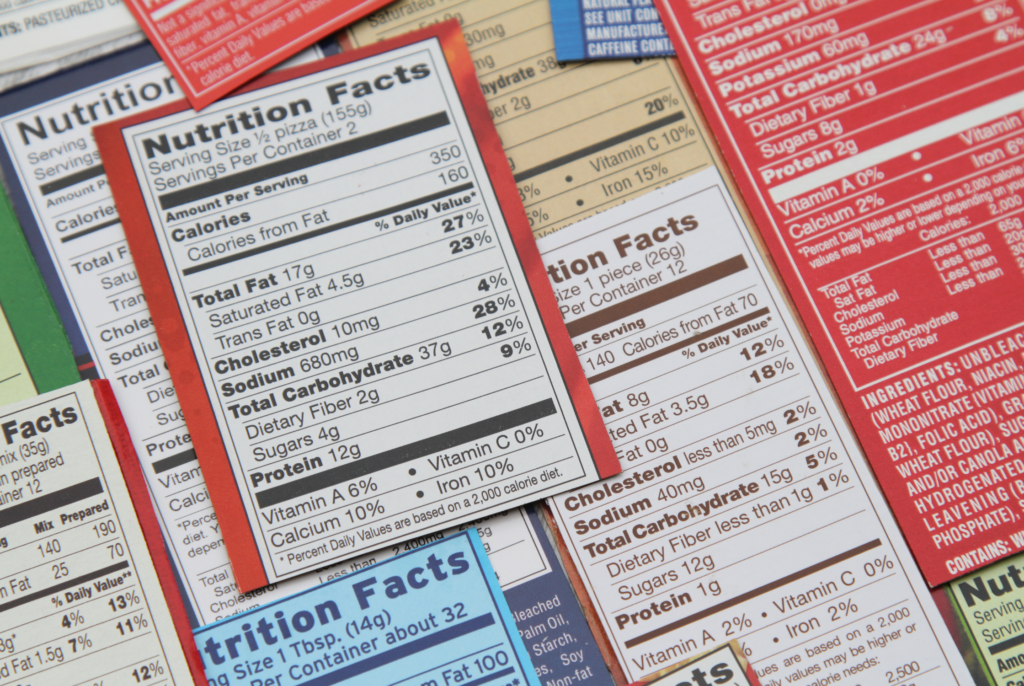
What to look for on the nutrition facts table and ingredient list
To nurture a healthy relationship with food for you and your family, the aim is to read the nutrition facts table through an “anti-diet culture” lens. Most of us (myself included!) have been conditioned to think of food in terms of “how many calories” it has, how high in sugar it is, or how much we have to exercise to “burn it off”. We may unintentionally role model disordered behaviours related to food and body image to our kiddos. But it doesn’t have to be that way. Here’s how to properly discern information on the nutrition facts label (through an anti-diet lens):
Don’t put a lot of focus on calories in a food product
In fact, if a food product boasts wording such as “low calorie”, “skinny”, “low fat” or diet-y slang like “keto-friendly”, reconsider bringing that product into your home altogether.
Understand the ingredient list
Ingredients are listed in order of weight, meaning that the most abundant ingredient is listed first. This can help you understand what ingredients make up the majority of the product you’re looking at, and help you to objectively discern which product you want to buy. For example, a more nutrient-dense cereal will have whole grains, whole grain flour, as well as dried fruit, nuts, and seeds listed before syrups and added sugars. Despite what you may hear in the media (and often from health professionals!), a longer ingredients list doesn’t necessarily mean “unhealthy”. It may just mean that there are lots of ingredients, including some that help to keep that food product safe, shelf-stable and affordable.
Compare the percent daily value (%DV) of micronutrients
This will help you to decide which product is more nutritionally dense in a certain nutrient. The percent daily value is listed to the right of nutrients listed such as vitamin A, vitamin C, calcium, iron, and fibre. If the product has less than 5% of a nutrient this means it has “a little”. If a product has 15% or more of a nutrient this means there is “a lot” per serving.
Don’t Stress about non-GMO or Organic labels
“Non-GMO” and “Organic” labels do not make the product a “healthier” choice. See the sections that explain this above!
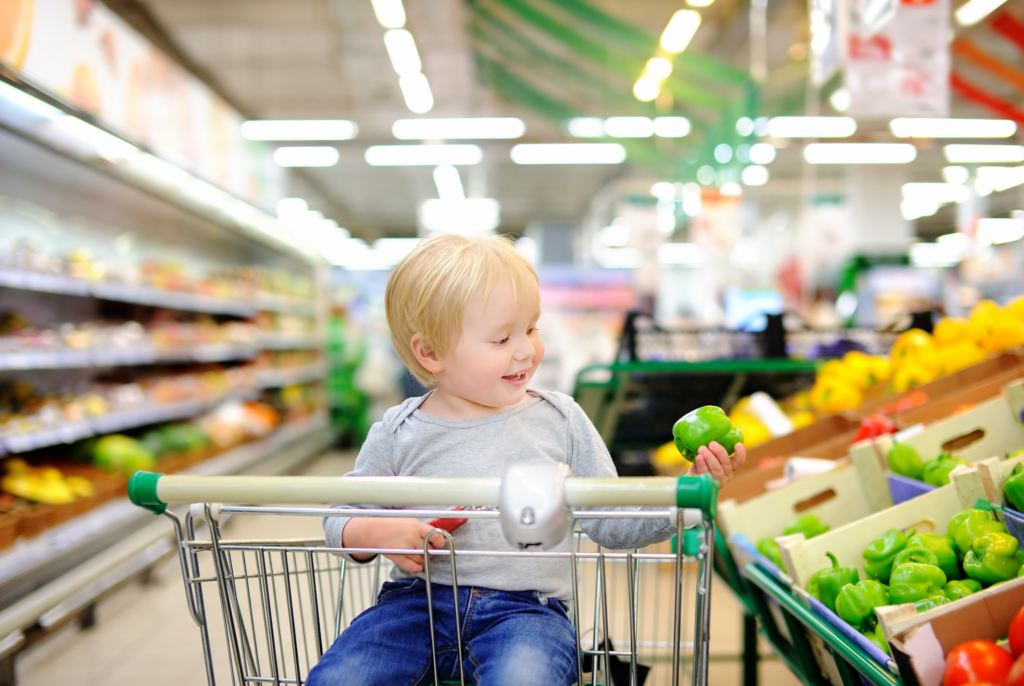
The number one thing you can do to get your kids to help (versus hinder) you when grocery shopping, is to get them involved in the process! You can do this simply by assigning them a personalized task or job for the trip. When kids feel they are solely responsible for something, it helps empower them to feel a sense of autonomy and independence (something kids start to crave more and more as they grow). Here are some ideas on how to get your kids involved:
- Get them to pick out one item during the trip that you will add to the menu: this could be a new fruit or vegetable they are curious about…or maybe they choose a new brand of pasta that comes in different shapes or colors!
- Give them a specific task such as holding the shopping list, pushing the cart, matching the coupons to food items, or finding a specific item in the store.
- Make it into a guessing game: Start describing the physical characteristics of items on your grocery list, and get your child to guess what item you are describing. Similar to the “I Spy” game, but with food they need to find and add to the grocery cart.
- Make it into a scavenger hunt: Ask your child to find items that are a certain color, flavor or start with a certain letter. For example, you could ask them to find foods that are red in the produce section. Or maybe you ask them to search for foods that taste sour in the dairy section!
Organize and lightly prepare your groceries for the week
I know, I know…just when you thought it was over. But trust me when I say that your future self will thank you for doing this! After unloading groceries, place them in their rightful spot (get older kids to help!). And here’s a tip—aim to put regularly used food items at eye level in the fridge and pantry, and group similar products together to help you quickly locate what you need. Keeping a well-organized pantry, fridge, and freezer helps to save space, prevent food waste, and can make preparing meals more efficient and enjoyable!
Here’s where the magic really happens. Lightly prepare key components of meals to save time when throwing together satisfying meals for the family! Here are some ways to lightly prepare your groceries:
- Cook batches of grains and starches such as roasted potatoes, rice, or quinoa.
- Prepare simple proteins such as slow-cooked shredded chicken or ground beef that can be easily incorporated into a variety of meals (such as tacos, burritos, pasta sauce, quesadillas, soups, and stir-fry’s)
- Roast a mix of veggies that can be added to bulk up the nutrients and satisfaction factor of any meal.
- Bake some muffins, baked oatmeal, or breakfast cookies to have a ready-made base for easy breakfasts or to throw into your child’s lunch kit as a delicious grab-and-go snack!
Future self, saved.
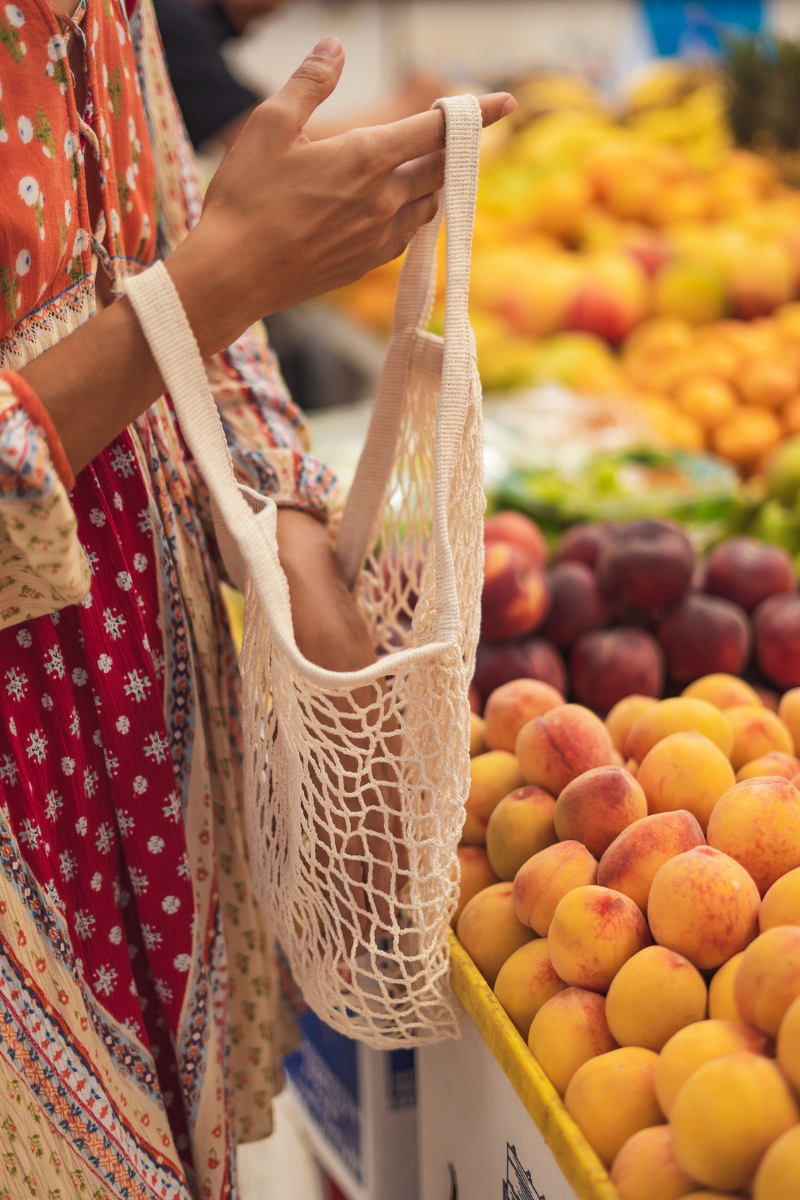
More grocery shopping tips to remember:
- Don’t shop on an empty stomach! We all know impulse buys skyrocket when grocery shopping when you are “hangry” …enough said.
- Don’t buy everything fresh! Fresh foods are great, but to save money and prevent food waste, focus on fresh “in-season” produce. Frozen, canned, and freeze-dried foods are also nutritious and should have their place in your freezer and pantry for the sake of longevity and convenience!
- Don’t be afraid to buy food in bulk (for selective items)! Buying in bulk helps save both packaging and money, but can create food waste if you aren’t careful. Only buy food items in bulk that are used often (and have enough space to store) such as meat, cheese, and non-perishable pantry staples like pasta, cereal, dried beans, and canned goods.
- Don’t forget reusable bags! One of my biggest face-palm moments is getting to the grocery store and realizing I forgot all of my (what feels like hundreds of) reusable bags at home, only to buy even more. Pro tip: leave a huge stack of reusable grocery bags in the trunk of your car! Replace them (as often as you remember) after unloading your groceries at home.
- Don’t bring all the kids with you (if you can help it)! Consider not bringing all your kids with you (if possible)! Managing one child at a time during grocery shopping can make the experience more impactful, efficient, and less stressful. This intentional one-on-one time allows you to focus on engaging with your child, exploring various foods and products together.
Bottom Line When it Comes to Grocery Shopping for Your Kids
In this blog post, you’ll find essential tips for grocery shopping for your kids in 2024. It’s time to ditch the old and rigid ways of shopping for your family and lean into variety, convenience and…fun! Remember that both organic and conventional options can be nutritious. And the more you can involve your kids in the shopping process and spend those extra few minutes to organize your groceries for efficiency, your shopping experience will be a success.

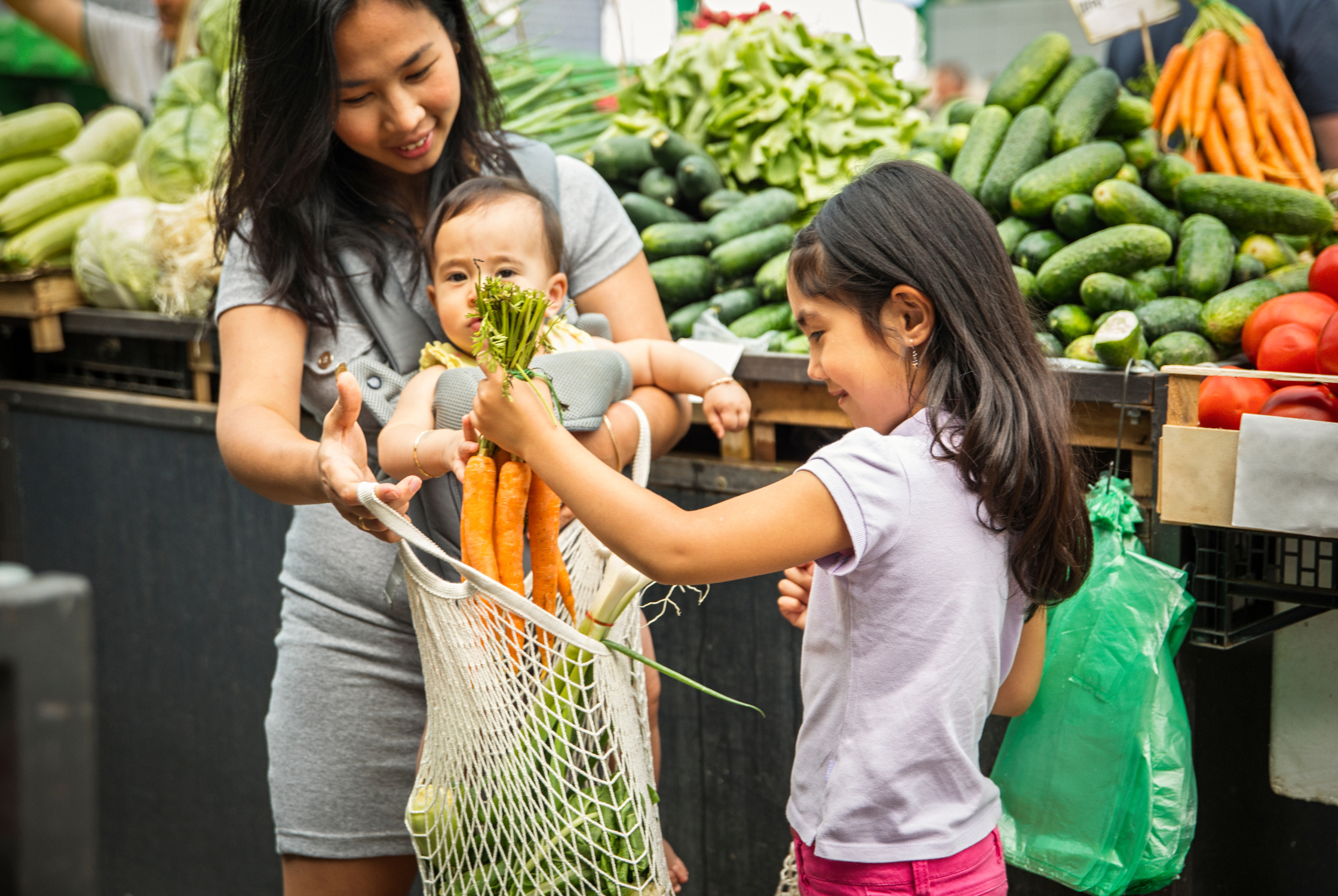



More Stories
United Healthcare’s ransomware attack shows why supply chains are under siege
Nutrition Tips For Ramadan | JM Nutrition
Probiotics for IBS | The Nutritionist Reviews